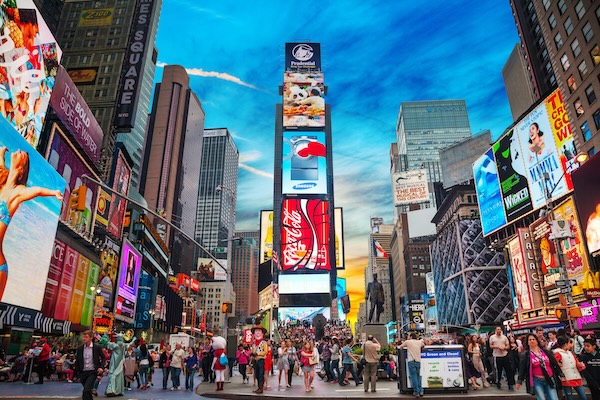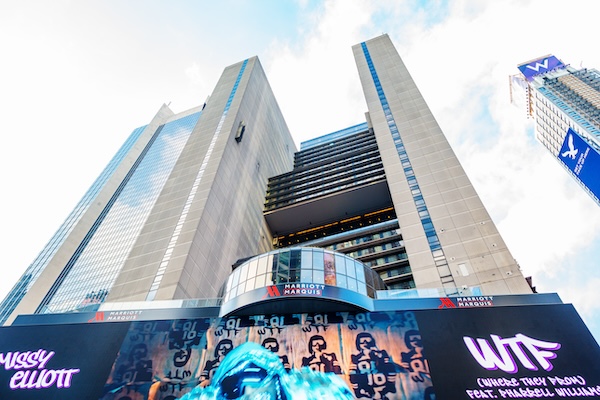With roughly one million revelers attending New York City’s New Year’s Eve celebration, the dawn of 2024 is an appropriate moment to consider the evolution of Times Square and hospitality’s place within it.
Situated at its epicenter, the original development and subsequent reinvention of the New York Marriott Marquis is an excellent example of the concepts of principle of change, and highest and best economic use.
During the first half of the 19th century, the area originally known as Longacre Square was controlled by John Jacob Astor, who made a second fortune selling off lots to hotels and other real estate concerns as the city rapidly spread uptown. During the last half of the century, as more profitable commerce and industrialization of lower Manhattan pushed northward, the area became known for its rollicking reputation as an entertainment district.
During the early 1900s, when The New York Times moved its operations to 42nd street, the area was named Times Square. As the growth in New York City continued, Times Square became a cultural hub of theaters, music halls and hotels, but by the 1920s, the area was besieged by crime and corruption, in the form of gambling and prostitution. The dangerous reputation of the area endured through the early 1990s.
Now, with roughly 360,000 pedestrian visitors per day amounting to more than 131 million a year, today, Times Square is the most visited place in the world.

Property Principles
Real property is in a constant state of flux and change, affecting individual properties, neighborhoods and cities. Economic, environmental, government and social forces affect all markets, particularly real estate. Highest and best use often is identified as the key concept supporting real estate use and value decisions. According to the doctrine, in any case where the market value of real property is sought, that value must be based on that use that would produce the highest value for a property, regardless of its actual current use.”
The highest and best use of a specific parcel of land is shaped by the competitive forces within the market where a property is located. The market value of real estate, which is predicated on highest and best use, represents a picture at a certain point in time within its constantly changing environment.
The New York Marriott Marquis is a classic case study of the dramatic changes that have occurred in New York City over the last 40-plus years. Planning for the development was first announced in 1972 when then Mayor John Lindsay approached John Portman, a prominent Atlanta-based architect and real estate developer, to design a major hotel in Times Square as part of a larger campaign to revitalize the crime-ridden neighborhood. The project was born in controversy because five historic theaters—the Helen Hayes, the Morosco, the Astor, the Bijou and the Gaiety—were demolished to clear the site in what was dubbed “The Great Theater Massacre of 1982.”
Located on Broadway between 45th and 46th streets, construction over a three-year period led to the hotel officially opening in October 1985. At a cost of more than $400 million, the project included approximately 1,900 guestrooms and suites, 80,000 square feet of meeting, banquet and exhibition space, and the 1,600-seat Marquis Theater. It’s often credited as the starting point of New York City’s commercial renaissance.

A Hotel for the Future
At the time, Portman’s style of inwardly oriented spaces made logical sense, although the development had been criticized for turning its back to the then seedy character of Times Square. A New York Times article titled—“Marriott Marquis Hotel: An Edsel In Time Sq.?”—published on August 31, 1985, described the building as “immense and determinedly futuristic, a gargantuan mass of concrete and glass, looming over Times Square like an upended bunker.” (An Edsel refers to a discontinued brand of car produced by the Ford Motor Company and, subsequently, has joined the lexicon to mean a product that fails to gain public acceptance.)
Fast forward to 2012, when Vornado Realty Trust (VNO) agreed to lease, redevelop and expand the retail portion of the hotel. The 20-year lease with the property owner, Host Hotels and Resorts, enabled VNO to purchase the space from Host at a price based on future cash flow. VNO invested roughly $140 million on improvements, including closing the arcade under the hotel and the creation of a glass facade for new retail stores positioned to face Broadway, which include 20,000 square feet on the ground floor and 25,000 square feet below grade. VNO also installed a 25,000-square-foot, 80-foot-high LED sign covering the Broadway face of the hotel, and which wraps 50 feet around each side of the building.
The New York Marriott Marquis evolved as its surroundings changed and, today, the highest and best economic use is orientation of the building outwardly to embrace the tremendous vibrancy of Times Square.
Another relevant example of the concepts of principle of change, and highest and best economic use, is The Hotel Pennsylvania. The hotel was located across from Madison Square Garden and permanently closed its doors on April 1st, 2020, a victim of the global pandemic. For more than 25 years, Vornado, owner of the 1,700 room hotel, has been desirous to redevelop the site located at 401 Seventh Avenue.
The notion of the Hotel Pennsylvania’s demolition was first introduced in 1997 when VNO acquired the property. It announced again in 2007 that the hotel would be demolished to make way for 15 Penn Plaza, a new office building with Merrill Lynch & Company as its anchor tenant. While the efforts of preservation activists to save the near century-old hotel initially provided a challenge to the proposed project, it was the Great Recession, which began in December 2007 and ultimately led to Merrill Lynch’s insolvency and subsequent sale to Bank of America, that put a full stop to the project.

While in 2007 the highest and best use of the Hotel Pennsylvania site appeared to be razing the structure and constructing a brand-new office tower, just one year later the global financial crisis rendered the economic feasibility of that proposed development untenable and halted the project.
A 2010 vote by the New York City Council approving construction of 15 Penn Plaza, a more than 2-million-square-foot office building on the site of the Hotel Pennsylvania, was perceived at the time as most likely the final chapter of this storied hotel’s economic life. But during late 2011, weak market conditions resulted in a delay of the structure’s demolition, and by 2013 the plan was entirely abandoned. Although VNO shortly thereafter announced a renovation of the hotel in 2018, its special permits regarding the proposed redevelopment with the NYC Planning Commission were renewed. During a Q1 2020 earnings call, Steven Roth, the founder and chairman of VNO, referred to the Hotel Pennsylvania as “a parking lot for a development site” and further stated, “we have thought internally about using this and just never reopening it.”
During 2008, the interim highest and best use of the property evolved to the continued use of the site as a functionally and physically obsolete hotel until such time when a proposed redevelopment of the site again became financially viable. When the Hotel Pennsylvania closed in 2020, the property was run down, and the New York hotel market outlook was bleak. The opportunity to use the closure to finally achieve VNO’s long-term vision to redevelop the prime site became obvious and demolition of the hotel, which commenced in January 2022, was completed in October 2023.
VNO’s most recent plan is to develop the site now being referred to as PENN 15 with a 56-story commercial 1,200-foot-tall skyscraper that will yield 2.7 million square feet of office space and stand as the centerpiece of the surrounding 18 million-square-foot Penn District master plan. Currently, the paradigm shifts in work from office, coupled with the recent dramatic and swift rise of interest rates, along with tight capital markets, are hindering economic feasibility to break ground. When the development pause ends, it will be interesting to see how much office space is ultimately built and whether the project will pivot to a mixed-use development.
